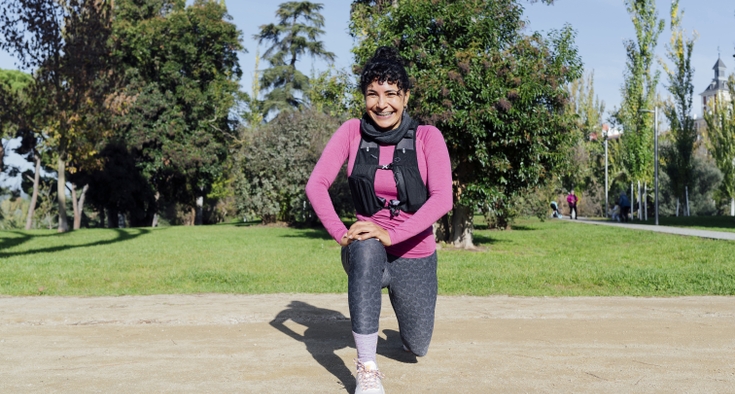There’s a Latin phrase (see below*) that translates to: “It is solved by walking.” That means we can often figure out answers to whatever’s troubling us simply by taking a walk.
But what if we could solve health problems by walking? What if walking led not just to a clearer head, but to weight loss and even disease prevention?
Guess what? It can.
The “Japanese walking method” — when paired with a proper diet — is a practical, proven way to lose weight, help maintain a healthy weight and even lower blood pressure. While the method isn’t necessarily more popular in Japan than elsewhere, it did originate at Japan’s Shinshu University.
It’s so accessible that anyone can do it. It doesn’t require special equipment or a gym membership. You simply walk at a high intensity for three minutes, followed by three minutes at a lower intensity and do that on repeat for at least 30 minutes, four or five times a week.
And if you can’t devote that many days to it, don’t discount it yet. Just two sessions a week can be beneficial, especially for people with limited mobility.
The Japanese method is a form of high-intensity interval training (HIIT), which is more effective than walking at a continuous pace for improving physical fitness, lowering blood pressure and enhancing blood sugar control.
Japanese walking is perfect for people who say they can’t find time to exercise. That’s because the focus is on proper intensity rather than duration.

While any walking is good for overall physical and mental health, this method in particular has health benefits. The higher-intensity component can help prevent chronic disease, lower the risk of diabetes and improve aerobic fitness more effectively than steady-pace walking.
Dr. John Cleek of Novant Health General Surgery and Bariatrics - Mount Pleasant has recently begun recommending the method to his patients. We talked to him about the regimen and a host of other issues related to diet and exercise. Our conversation has been lightly edited for length.
Make an appointment with Dr. John Cleek
Good health starts with a great doctor. Find one near you.
Who is the Japanese walking method right for? Is there anyone who shouldn’t try it?
It's right for anybody who's just starting an exercise program or has been walking at a moderate pace on an ongoing basis. For those people, this will pick up the intensity of their workouts.
If you’re somebody who already runs three or more miles a day, this isn't going to help you. You’re already in better shape than the program would provide.
How exactly do you do Japanese walking?
Start with a warm-up by walking at a normal pace for a few minutes.
Then, pick up the pace and walk briskly for three minutes. At this pace, you should still be able to have a conversation. But it’s not a stroll. Next, walk at faster speed where it's difficult to hold a long conversation.
Continue alternating between brisk and even faster for a total of 30 minutes. Alternating paces is important because it allows for a longer sustained effort by letting the heart rate come back down.
Is this meant to be sort of a gateway to more exercise, or is this something people can continue to do?
It's both. It’s a good way to start, and it can be continued.
But there’s an upper limit. It’s three minutes at a brisk pace and then three minutes at a faster pace. There’s really no benefit to going beyond 50 minutes a week at a fast pace. That’s not to say you can’t continue walking — at a normal pace — as long as you want.
If someone who’s been sedentary and never able to maintain an exercise routine takes up Japanese walking four or five days a week, how long might it take for them to see results?
Six months. Maybe more. Remember: Weight loss is 80% diet. Only 20% of weight loss is exercise-related, so you're not going to see a lot of weight loss just from increasing exercise.Where exercise is critical is keeping the weight off, because 80% of weight maintenance is said to be related to your activity levels and 20% related to your diet.
How does this method enhance blood sugar (glycemic) control?
The higher intensity exercise burns more calories and uses more blood sugar for energy, which helps improve insulin resistance by helping people lose more weight.
This must be done in combination with appropriate diet, right? Is there one you recommend to most patients?
Yes, diet is crucial. And the best diet is whatever one somebody can stick to. But it should have adequate protein. You can't have low protein and do well with a diet because you'll lose muscle. I'm not a fan of diets where you cut out whole categories of food. They’re generally not sustainable long term, and it's harder to get your balanced nutrition.
Tell me about your own diet.
Recently, I’ve been having protein drinks for breakfast, half a sandwich — with four ounces of protein — for lunch and then a more balanced and sometimes larger dinner.
Is there a certain brand of protein drink you recommend?
Anything with about 30 grams of protein, with whey protein primarily, is best. It’s up to individual taste, just like everything else.
Do you snack? And are there any healthy snacks you recommend?
Oh, certainly you can snack. I don't, because I don’t have time between patients. But healthy snacks would include apple slices with peanut butter, a few almonds, cheese sticks and yogurt. If you notice, these all have some protein in addition to other components.I understand that you’ve occasionally struggled with weight. How has that made you a more compassionate doctor?
That’s what drove me to practice obesity medicine to begin with.
My first diet was in third grade, and it was more of a Weight Watchers-style, counting calories kind of diet. But I kept having weight struggles. I peaked at about 260 pounds, and I got into weight management with fen-phen (a combination of two diet drugs, fenfluramine and phentermine, that has since been taken off the market due to serious health risks).
Have you been able to maintain a weight you're happy with?
Like many people, my weight has fluctuated. I got back up to about 240 pounds at one point. But now, I try to follow the advice I give patients. I’m back down to 185 pounds and have been stable there for the last year or two.Do you get on the scale every day?
Yes, I do.
And do you recommend that to patients? Is it important for maintaining a healthy weight?
I think it's important for maintaining, but not for losing weight. For many people trying to lose weight, if they don't see it go down every day, it’s a terrible day. It makes or breaks their day.
And the scale is still only one measure of success. It’s all the other measures people forget to watch — blood sugar, cholesterol, how much more they can do in a given day without being short of breath or overly fatigued. The scale is just one measure of health, and it’s not the ultimate measure.
* Solvitur ambulando is a Latin expression often attributed to Saint Augustine.
An obesity doctor weighs in on weight-loss medications
Most of us had never heard of GLP-1 (glucagon-like peptide-1) until a couple of years ago. The hormone that plays a role in regulating blood sugar and promoting weight loss has dominated our newsfeeds in recent years.
Chances are, you know someone who’s lost weight using a GLP-1 agonist — a class of medications used to treat Type 2 diabetes and obesity. Those injectable drugs include brand names you’ve surely seen advertised: Ozempic, Wegovy, Mounjaro, Zepbound and others.
We asked Dr. John Cleek for his thoughts on the drugs.
Is it too soon to say if patients on GLP-1 agonists need to be on them for a lifetime?
As far as we know, that's the case — or at least until something better comes along. Or something different anyway.
And on that topic, the injection alone is not sufficient. It needs to be used in combination with an exercise program and healthy dietary changes, including higher protein. A lot of the negative publicity recently has been over muscle loss while on the injections. But if you're on the appropriate diet with higher protein and you're being active — especially if you're doing some strength training — the muscle loss is minimized.
I heard that tirzepatide (marketed under the brand names Mounjaro and Zepbound) may be available soon in pill form. Is that true? And if so, what are your thoughts on it?
Eli Lilly, the company that makes tirzepatide, has just released a study showing some significant results from a new molecule that’s like tirzepatide. But it’s not tirzepatide.
It may be available next year, and it looks like it could be useful in treating diabetes, but it doesn't have great weight loss results unless you go very high on the dose. And it comes with the same side effects as the injection form.
The most common are GI issues such as nausea, diarrhea, constipation and vomiting. Those are most likely to occur when first starting the drug and when bumping up the dose, and they usually subside within a couple of weeks.












